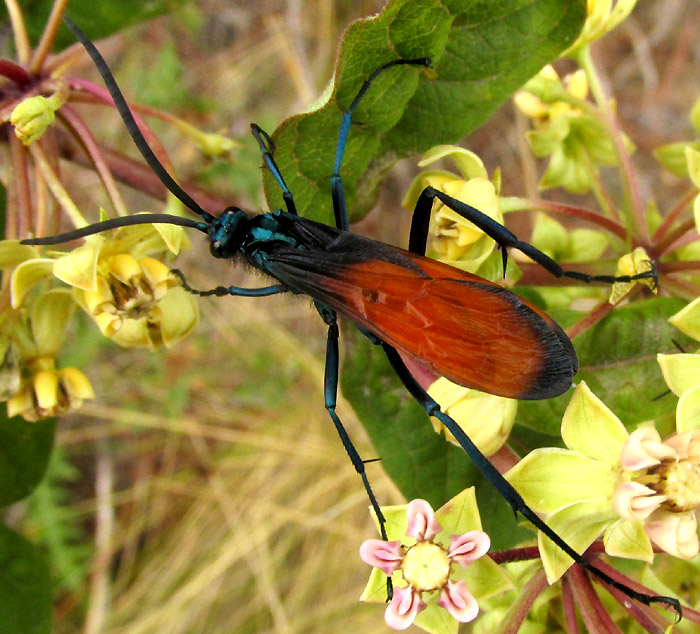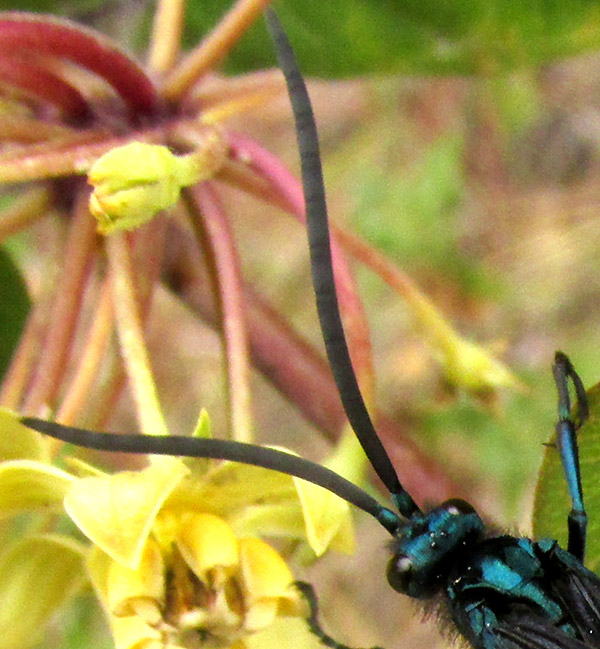Excerpts from Jim Conrad's
Naturalist Newsletter
Entry from field notes dated June 29, 2023, taken along one-lane gravel road in valley between Puerto del Zenthé and Chavarrías in mountainous area with a maze of roads too complex to say how to get there; in general it's in the mountains of east-central Querétaro state, municipality of Cadereyta de Montes, 12 straight-line kms due east of Vizarrón de Montes but much farther by twisting roads; juniper-scrub forest; limestone bedrock; elevation ~2860m (~9400 ft), Querétaro, MÉXICO, (N20.84122°, W99.60509°)
TARANTULA HAWK WASP

The above tarantula hawk wasp was one of two who hesitated to leave the head of milkweed flowers, Asclepias ovata, they occupied as I photographed the blossoms' details close-up. Another view of the wasp, from behind and showing the curved-down abdomen, emphasizes its waspish nature:

This kind of big wasp is commonly seen in much of Mexico, but normally they're spotted zigzagging close to the ground, hunting tarantulas, and thus hard to photograph. However, the individuals on the milkweed flowers seemed almost drugged and lethargic; I had to shake the flowers to get them to leave. Having them out of the way was a good idea, since tarantula hawks are famed for their powerful stings.
About five tarantula hawk wasp species, genus Pepsis, are documented for Mexico, and their taxonomy isn't well settled. Therefore, for identification to species level, it's good to look at details. Here's a close-up of the head and antennae:

And venation in the wings:

These details lead to PEPSIS GROSSA, until 2002 regarded as Pepsis formosa, with confusion about the various color forms. The species occurs from the southwestern quarter of the US into northern South America. It's the state insect of New Mexico.
Wikipedia's Pepsis grossa page goes into detail about the species' life history and taxonomy. The short story is that only the females hunt for tarantulas, which they sting, drag to their burrows, and lay a single egg on the paralyzed but not killed tarantula, then seals the chamber. The larva hatching from the egg slowly consumes the living tarantula, when finished weaves itself a silken cocoon, and metamorphoses into a pupa, from which eventually it emerges as an adult.
My caution with the individual above may have been out of place, since only the females sting. Though the above wasp was larger than most wasp species, it didn't seem as big as the females usually noticed hunting close to the ground. Male body lengths (excluding wings) measure 24-40mm (7/8 to 1-7/64inch), while the females' measure 30-51mm (11-3/16 to 2 inches). However, the female's sting is considered the second most painful of all insect stings, so maybe wariness about smaller ones is appropriate.
Despite the female's powerful sting, Pepsis grossa has its enemies. Kingbird species sometimes eat them, but Greater Roadrunners may be their main nemesis. Not only are roadrunners known to feed on tarantula hawk wasps, but sometimes they steal the wasp's paralyzed tarantula and eat it themselves.